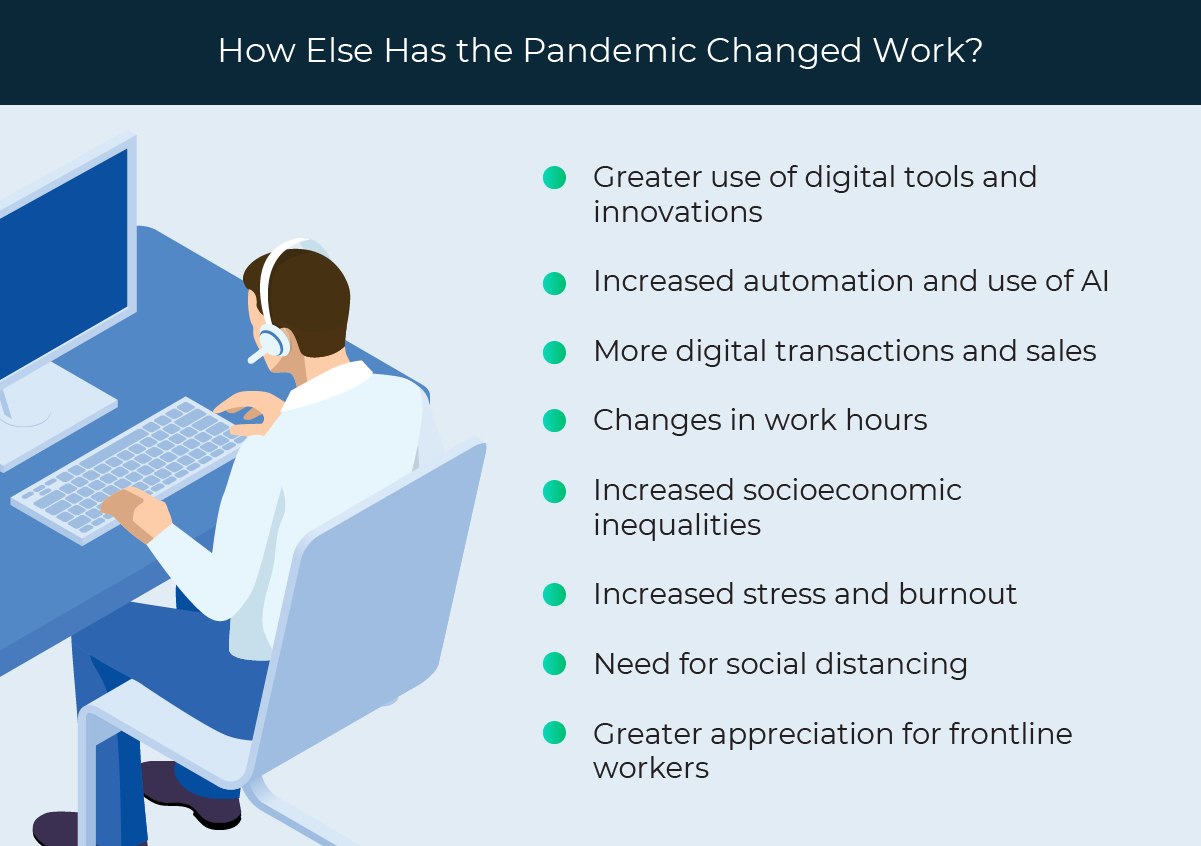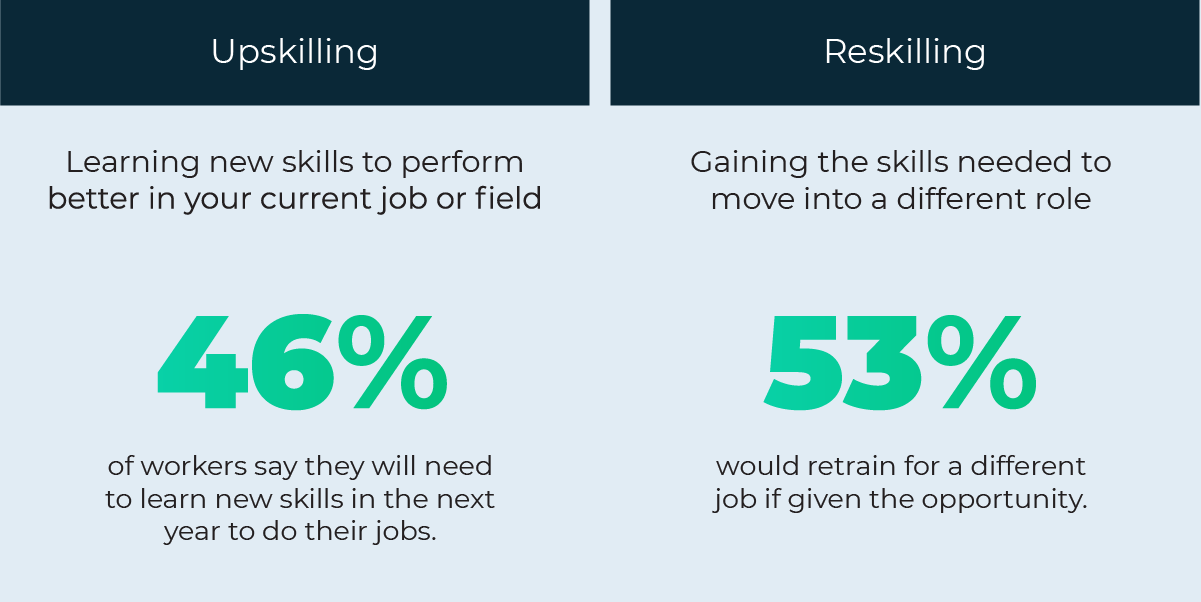How to Close the Skills Gap Widened by COVID-19

COVID-19 has radically changed the way we work and interact with one another. Even as restrictions continue to lift and we move toward a “new normal,” the workplace trends the pandemic has accelerated will shape the workplace for years to come.
Alongside changes such as the shift to hybrid and flexible work, COVID-19 has exacerbated skills gaps and highlighted inequalities in the workforce. In fact, McKinsey & Company found that 87% of companies are either experiencing a skills gap in their workforce or anticipating one within the next few years.

At the same time, employees perceive personal risk—nearly half of workers surveyed in 2020 expressed concern that they would lose their jobs due to lack of skills within the next five years, and 86% say they wish their employer would give them more opportunities to reskill.
Organizations and employees alike stand to benefit significantly from concerted efforts to close these skills gaps and prepare employees for the future of work. In this new economy, training and development have moved from “nice-to-have” to essential.

What Is a Skills Gap?
A skills gap exists when too few or none of an organization’s employees possess the skills necessary to meet the company’s needs. Skills gaps can emerge around hard or soft skills. They can develop quickly as the organization’s products, services, or goals change, or as technology and workplace norms shift. Companies are particularly vulnerable to skills gaps in areas where talent is in high demand, like tech specialties (such as cybersecurity).
Those gaps bring serious economic consequences—Accenture has predicted that if skill-building doesn’t catch up with technological progress, the G20 economies could lose up to $11.5 trillion in growth over the next decade.
Upskilling and Reskilling to Close the Skills Gap
In a tight hiring market, seeking new talent outside the organization may not always be a viable option due to the high cost of recruitment and long hiring timelines. But no matter the availability of workers, more than half of organizational leaders prefer to fill skills gaps through reskilling and upskilling, and for good reason.
According to LinkedIn Learning, 94% of employees would stay with their organization longer if it invested in their training and growth. Filling skills gaps from within promotes employee retention while also ensuring that new skills are paired with the organizational knowledge that makes long-term employees so valuable. Plus, reskilling from within is much more cost-effective. PWC UK and the Financial Services Skills Commission found that organizations can save up to £49,100 ($65,804) per employee.
Organizations can use two primary paths to build employees’ skills and close the skills gap: upskilling, which utilizes learning and development programs to build on existing skill sets, and reskilling, which imparts entirely new skills to help employees shift into a different role.

Identifying COVID-19 Skills Gaps
Soft Skills in Demand
Soft skills, the traits and behaviors that are not tied to specific technical knowledge but are essential to thriving in the workplace, are increasingly important in the less-structured world of hybrid and remote work. Key soft skills companies need in today’s changing workforce include:
- Leadership and management (especially for remote or hybrid teams)
- Critical thinking and decision making
- Creativity
- Flexibility and adaptability
- Digital literacy and communication
Hard Skills in Demand
In a world increasingly reliant on digital tools and automation, technical skills are also in short supply for many organizations. Some of the most in-demand skills in 2022 include:
- Artificial intelligence and machine learning
- Data science and analytics
- Automation
- Business strategy
- Digital transformation

Close the Skills Gap Through Upskilling and Reskilling
While addressing skill gaps within an existing workforce may seem daunting, there are numerous tried and tested strategies to help organizations prepare for the needs of the future. They include the following.
1. Identify priority areas, skills in demand, and open roles.
While most employees can benefit from reskilling and upskilling, companies should systematically identify their most pressing needs when planning to address skills gaps. To identify those needs, leaders should look at their organizational priorities, identify the skills needed, assess their availability within and outside the company, and consider which open roles could be filled with internal candidates given appropriate training.
2. Communicate why upskilling and reskilling are needed.
Buy-in across the organization, from the leadership team to entry-level employees, is necessary to the success of an upskilling and reskilling program. Companies should make it clear to their employees that taking the opportunity to grow their skills will directly correlate with increased opportunities for advancement in the organization.
3. Enroll employees in courses or training programs.
Formal development programs are the fastest and most effective way to build both hard and soft skills within an organization. During the pandemic, online training programs have become an even more sought-after option. Short online courses (like those Emeritus offers) are especially effective due to their targeted approach and cohort-based learning pathways.
4. Utilize internal mentors and external experts.
Sometimes, skills gaps reflect a lack of enough internal resources, rather than a lack of any. In those cases, internal mentorship programs and one-on-one coaching may provide a solid start, especially if you pair them with more formalized programs. If internal resources are lacking, bringing in external experts for coaching may also be a viable option.
5. Provide stretch assignments for employees.
Stretch assignments, or assignments outside an employee’s usual scope of work, provide the opportunity to develop skills in a hands-on way. This approach can be especially effective for building skills like project management and leadership.
6. Follow up with your staff and track progress.
Like any investment an organization makes, it’s essential to track outcomes and measure the ROI of upskilling and reskilling initiatives. In addition to measuring business KPIs, organizations should also include learning metrics in employee development plans and assessments to track progress on an individual level.
Benefits to Closing the Skills Gap
Closing skills gaps has clear benefits for both employees and employers, making upskilling and reskilling a win-win proposition.
For Companies
- Increased employee engagement and retention
- A workforce better equipped to meet the organization’s needs
- A culture of learning and growth
- Cost savings compared to hiring new employees
For Employees
- Improved performance in their current role or the ability to take on a new role
- Increased opportunities for growth and advancement
- Improved confidence and morale
- Increased adaptability in the context of a rapidly changing environment

At the global level, the skills crisis is growing, and it’s only been hastened by the pandemic. But that doesn’t mean organizations need to give in and accept a workforce that’s unprepared for the future. Careful planning and targeted investments in skills development will not only pay dividends for companies but also build employee engagement and retention for years to come.
Working to close the skills gaps that now exist within your organization? Emeritus offers online courses targeted at the hard and soft skills the employees of today and tomorrow need. Contact the Emeritus Enterprise team to build a skills development plan to meet your company’s unique needs.


